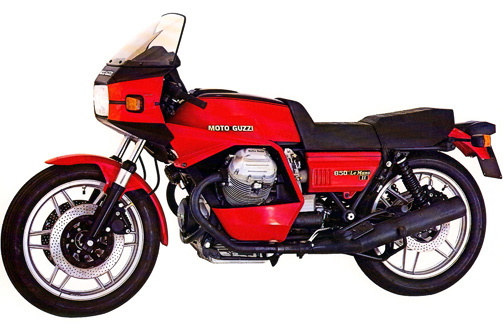The rebuild: Autumn 1994 – a new bike
I was missing not owning a bike: I’d given up motorcycling a few
years ago, after my last three bikes had been stolen in short succession,
but I’d just discovered a local shop, Wessons
Motorcycles, as it was called then, that specialised in Moto Guzzis.
I’d admired the Moto Guzzi Le Mans ‘Mark I’ ever since
I was a teenager in the 1970s (Figure 1), and eventually had
enough money to buy one in the mid-1980s, but that too had been stolen,
after a scant few months of ownership. Suffering from nostalgia, on
the spur of the moment I phoned Wessons and asked if they had a cheap
Le Mans. I expected their reply to be ‘no’, and buying another
bike was really just an idle thought anyway. But they did have one,
a Mark II imported from Spain, built in 1981 (Figure 2). The
least I could do was look at it.
The large, angular fairing made the bike seem ugly, not at all like the sleek Mark I. Its looks weren’t improved by the previous owner painting it, sloppily, metal-flake black. It had also been dropped a few times. However, it was mechanically sound and Wessons had overhauled it, and the price was low, a little over £2000. I bought it.

Figure 1. The Moto Guzzi Le Mans ‘Mark I’ (produced from 1976 to 1978). This is a late version, and is standard apart from the nose fairing, which should have a wide dayglo-orange stripe.
I spent the next month converting my new Guzzi into a Mark I (the differences are only cosmetic), which mainly involved replacing the Mark II fairing with the small Mark I one, and throwing away the huge, and very ugly, rubber instrument surround. I also repainted the bike – in red, as befitted its Italian racing pedigree. I made one more change: delinking the front and rear brakes, as I prefer separate brakes.

Figure 2. The Moto Guzzi Le Mans Mark II (produced from 1978 to 1981). It is essentially a Mark I with new clothes. The touring fairing is certainly practical, but many, including myself, think that the Mark II’s looks are inferior to the Mark I’s, which is a design classic.
The Le Mans was not an easy bike to ride: the riding position was awkward, the clutch was so heavy that my hand always ached, there was a flat spot at exactly 30 mph (the urban speed limit here in the UK), the steering lock was so minimal that three-point turns became 30-point turns, and the bike was always falling off its prop stand. But whenever I turned onto a country road it transformed into the thoroughbred that won countless races in it heyday. I loved it!
 Autumn 1994
Autumn 1994
